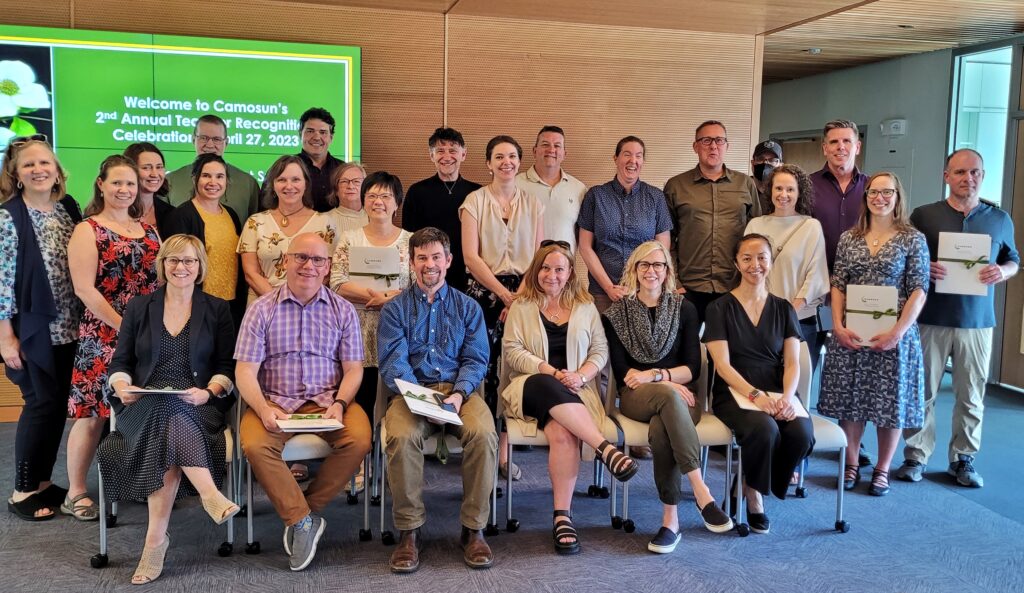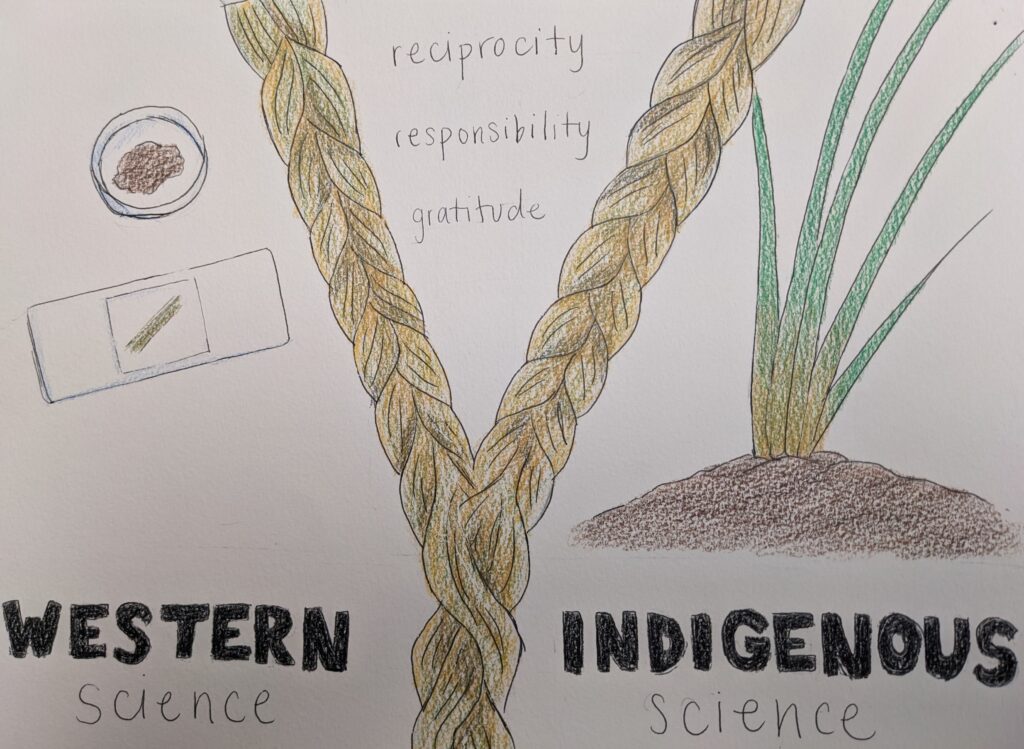Over the past year or more I have been sharing stories from Camosun faculty about their move to online teaching during the first 2½ years of the pandemic. Last month I facilitated a discussion at our Walls Optional workshop with some of those faculty and as we wrapped up our session, I began to reflect that there are more stories to share. As I left for a walk after the session, our Director, Sybil, asked if I would interview her, and I replied, of course! And so here is the first in a series of stories from a variety of other perspectives, still stories of the last few years, but through different lenses. Sybil is retiring at the end of May this year, and I want to thank her for taking the time for speaking to me in what must be a last tumultuous month for her, and to thank her for leading the Library and Learning Services for these many years.
We started our conversation as all my conversations with faculty have started: tell me what it was like for you when everything moved online back in March 2020. “I had been on vacation and recall coming back to a growing sense of anxiety at the college. People were asking me what’s going to happen? We started in the library with more hand sanitizers and signs about good hand washing technique, but you knew that there was something more coming. Then on that Saturday, I think it was March 12, college leadership senior leadership was called to a meeting with the President to talk about what we were going to do the next week, everything from, moving online, what would be required, what communications were needed, what about our clinical courses, are the supports ready from eLearning, do people have adequate equipment at home. Everything from operational to education delivery to supporting students.” I should pause here and tell you that Sybil oversees (at the time of this writing, as she is retiring soon) the Library, our Writing Centre, and the Centre of Excellent in Teaching and Learning (of which my unit, eLearning, is a part.) So here she was, trying to manage not only “the group of people responsible for getting things online, but also perhaps the most important space at the college for students. And it’s not just space, but it’s computer access. It’s about printing, it’s about Wi-Fi, it’s about their reserve textbooks.”
That initial week everyone was in crisis mode. “Information was constantly changing, hour to hour to hour, so my concern was keeping everybody informed and also making sure they felt supported and not like they were alone out there.” Sybil recalled at one point watching Trudeau speaking to the nation in our large meeting room in the Lansdowne library. “Usually, we would all come into the meeting room with lots of chit-chat, but this time you could sense the apprehension, the fear, and the worry. But watching Trudeau you felt connected to something that was happening globally which I think was just really important.”
As the week went on, our group (eLearning) moved our operations to remote work. It made sense for what we do, and as Sybil noted, we had huge demands on our time as faculty and students moved to online teaching and learning. But we weren’t just fielding questions about online teaching, but also has “people needing to talk because of their fear and the worry and you were filling that dual role of supporting somebody in the moment but also being really clear and providing the information and support they needed.” But while we were navigating our own workload remotely, “the college was still open, including the libraries.” Sybil told me that those were the hardest days for her. “I remember talking to my colleagues, particularly at UVic, what while classes moved online, everybody else was still on campus. And the libraries actually became busier because some students had nowhere to go.” Gradually, however, the libraries began to reduce hours and eventually the Interurban library was closed, and some staff moved to Lansdowne. Then Sybil had to close that library down as well. Sybil told me that this was an especially emotional moment for her because no one knew what was coming. “I remember thinking, the next time we’re altogether, people could have experienced loss. Whether it’s two weeks or a year, we will come back and be different. It was one of those moments of feeling so connected and yet also feeling so alone.”
While that first part of March was so very emotional, Sybil knew she had a responsibility for the people working for her, as well as for students who still needed the library to complete their coursework, “from making sure people had the equipment they needed and proper Wi-Fi access at home, to emotional support for people. And of course, layered onto that were personal worries, about my mom who’s 90, my sister who works in an emergency department, my brother who lives in the States. Everything slammed you all at once.”
What happened next? Well, lots as it turned out. “We made printing free for students right away. We started doing books by mail. I worked with IT and my colleague Evan the director of Student Affairs to provide clear information to students about a whole range of things related to technology. It was an opportunity for us to bring our expertise together and work in collaboration to rethink how to maintain our operations and support students. Fortunately, we had a lot of good systems already in place, so thinking about how to we make good use of them and level them up. For example, in eLearning we had three major tools in place, tools the department already had comfort with and expertise in, so thinking about how to use them to their full capacity rather than looking for something new. Another example was how we took our existing interlibrary loans system and adapted it to provide books by mail on a larger scale.”
Communication and connection were also key for Sybil. “We collectively met a lot in those early days, first daily and then weekly. Those meetings served a number of purposes: one to break down feelings of isolation, and two to hear points of view about what was going on, to see what connections you could make and what the possibilities were.” Sybil likened these meetings to emergency operation centres, as one place where all the communication happened. “There was so much energy in hearing that everywhere everybody else was flat out, that gave me the inspiration, motivation to continue to do that response, response, response.” Eventually things settled, “it wasn’t really settling or acceptance, but you could see that this was going to be the way we would be operating for a while.”
We talked a bit about this strange place we are all finding ourselves in right now, transitioning from COVID response to something not quite the same as it was pre-March 2020 “I am a huge fan of William Bridges’ work about managing transitions, and the hardest time is the in-between from what was to what will be. When we were in it, as hard as it was, it was very clear what we needed to do: make sure instructors could, on a day-to-day basis, deliver the courses to students and make sure students were supported in every way possible so they could complete their schoolwork. But now we’re in this transition.” To what? Some people call it the “new normal”, a term Sybil resists. “Normality to me suggests what the majority wants – it doesn’t recognize the diversity of the community.” We agreed that, in fact, we have been forever changed by the past two years. Sybil likened it to something Neil Postman wrote about technological change. “He said, technological change is not additive, it’s ecological, and it changes the whole nature of what you’re doing.” In other words, there is no going back to what was before.
I asked Sybil what she thought her biggest challenge was back in 2020. She told me “There are two aspects to my role as a leader that I found really hard. First, I felt this huge responsibility for everybody’s well-being. I worried how everybody was doing knowing that people in my area were working flat out. I probably beat myself up too much about it, feeling that I wasn’t doing all that I should or could. Second, I found during the pandemic, I felt some of my ethics, values, and beliefs being challenged.” For example, trying to balance issues around privacy when trying to apply a technological solution to a pedagogical problem – namely adopting proctoring software to enforce academic integrity. In addition, Sybil struggled with ensuring marginalized students had equal access to education, “knowing that some students, and some instructors, fell in between the cracks as we celebrated our pivot to online. It doesn’t matter that 70 percent of us were okay; the impact on that 20 or 30 percent left behind was huge, and there was a group of people that were lost. So yes, for me it was how do I maneuver through this while maintaining my strong beliefs and not put aside the things that I care about. I think sometimes in a crisis, values can be eroded, so you have a responsibility to stand up even more for them.”
But through all the challenges, there were rewards as well, and for Sybil, she was most proud of the fact that “we were able to open the libraries safely back up to limited hours in September 2020, well ahead of many of our colleagues around the province. Students had access, they could get a bus pass safely, they could borrow a computer or Wi-Fi access, or they could come in if they needed a space to work.” Sybil remembers one student who told her if that if hadn’t been for the libraries being open, he would not have been able to continue going to school. In addition, she recalled the accolades the teaching and learning group were receiving. Sybil even reminded me about the amazing video the English faculty created to thank the eLearning group for all their support. “Those moments were just so powerful, hearing from instructors over and over again. Every time I would go to an educational or senior leadership meeting, they would tell me people in CETL are rock stars. As much as it was so hard, I think those moments showed how we, in our department, share those values and principles about delivering quality experiences, and how we have that ethic of care and empathy around the work that we do. We meet people where they’re at and help them move along. I saw that over and over and over again because everybody had a strong personal commitment to a principled and values-based approach to the work. That that’s what got us through. It wasn’t because we just were technical experts, it was because we were strong and shared that same set of values and principles about doing our work.”
Sybil reflected a bit on some of the lessons learned over the past couple of years. “When you push yourself emotionally, physically, intellectually, you realize what we are all capable of. I think so often in the ease of the day-to-day we don’t let ourselves blossom and flourish, but when you’re pushed to the edge, you see what’s possible. As hard as it was, we knew we could do it. There is a Rumi poem that says, ‘out beyond the wrong-doing and the right-doing, there’s a field. I’ll meet you there.’ We were in that field for a good number of months, and being in that field, anything was possible.”
Sybil has some words of advice for other leaders finding themselves in similar situations: “never underestimate the importance of clear communication and communicating in multiple ways. You need to be seen and be available and be heard. I made up a service continuity plan in fall 2021 when Omicron was coming, because you need to know, if you have a number of people sick, what your priority service will be: this is what we stop doing and this is what we have to keep doing. If I was to continue, I would dust off a service continuity plan every year. It could be another global pandemic, with climate change many other things could happen and it’s important to have a solid plan.”
As we wrapped up our interview, something Sybil said really resonated with me: “I don’t subscribe to the belief that COVID happened for a reason, but I believe we have to find learning and lessons from it. If you read about the pandemic of 1918, we find the same fears and worries, but we came through it. We as humans do learn from experiences and we go on, even though it’s so scary in the moment. But we will get through this. I hope people take the time and read some of the stories that you’re documenting. It’s not just about the practical things, like service continuity plans, and leveraging the technology tools you have in place. You also need to listen to and remember and reflect on the human stories because that’s where we learn.”
 Congratulations to 28 faculty from across Camosun College who are being recognized for their contribution to teaching and learning!
Congratulations to 28 faculty from across Camosun College who are being recognized for their contribution to teaching and learning!

